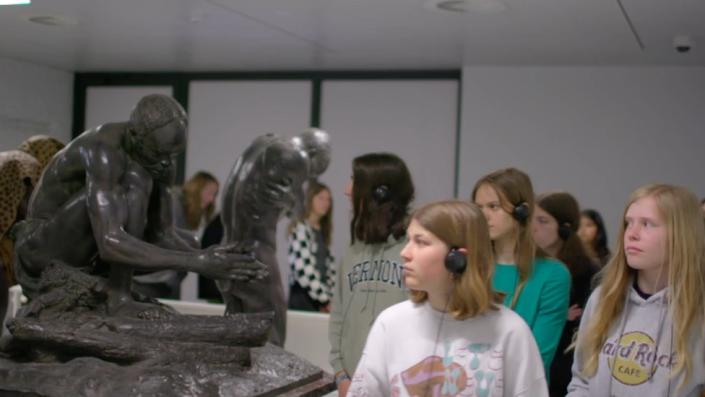
In the darkest corner of a grand, neo-classical palace-like museum is a not-so-secret room.
It is filled with statues of Congolese, considered racist, which were once part of the permanent exhibition.
Schoolchildren on an educational tour parade past the Leopard Man, men with spears and nearly naked women.
This is the Africa Museum in Tervuren, just outside Brussels, and until recently these sculptures were part of the permanent exhibition.
After facing years of strong national and international criticism, the museum has worked with a group of African diaspora experts in Belgium to rethink the controversial statues on display.
Colonial history
The museum traces its origins to when King Leopold II set up the 1897 International Exhibition. As part of this, 267 Congolese men, women and children were forcibly taken to Belgium and displayed to the public in mock fenced villages on the site where the museum now exists.
When Belgium gained independence from the Netherlands in the 19th century, the “scramble for Africa” of Western nations was in full swing. King Leopold II wanted his own slice of the continent, but without government support he had to win over investors and the public.
The “human zoo” was a tool to convince visitors that Belgium had a duty to bring civilization and Christianity to the African country. The exhibition was a huge success and so began the long and violent history of Belgium in the Congo.
Fast forward to the present and the museum is now celebrating its 125th year. It’s also been five years since it underwent a massive refurbishment, where it removed problematic statues and changed labeling around objects that created a negative stereotype about Africa.
Guido Gryseels was the museum’s director until he retired earlier this year, aged 70, and is largely responsible for bringing about change.
Visitor numbers have improved since the revamp, but some members of the African diaspora believe more can be done and the statues should be removed altogether. Others say the museum should no longer exist given its historical exhibits depicting African people as primitive.
The museum says it cannot change the past, but is committed to doing its part to build a better future.
“We realized that most children had their first encounter with Africa during a visit to this museum, either when they came with school or with their parents,” Mr Gryseels told the BBC. .
“For 100 years that impression was basically a feeling of stereotypes, that Africa was good at providing nature and we were good at providing culture. From stereotypes you get prejudice and prejudice you get a certain dose of racism.”
When Mr Gryseels joined the museum in 2001, a survey showed that 95% of Belgians thought colonization was a good thing. In 2022, the survey was redone and the number dropped to 35%.
Work in progress
Despite the best efforts of the museum, part of its history remains barely veiled. In a beautiful round atrium called the Rotonde, colorful curtains hang along the walls.
Behind them, you can see larger-than-life statues with matching French inscriptions such as “Belgium bringing civilization to the Congo”, which means “Belgium brings civilization to the Congo”.

“Belgium brings security to the Congo” is inscribed on a plaque below a golden statue resembling a goddess with a Congolese child at her feet. The counter-narrative image depicts an armed Belgian soldier holding a machine gun. Another statue shows a Congolese man battling a snake.
“Here you will notice that the statue is black and the others are gold, because gold is considered superior, as divine, but it is for someone inferior”, explains Marie-Reine Iyumva, collaborator of the Africa Museum.
She is part of a new generation of African-born staff uniquely driven to bring about change and provide context.
Ms. Iyumva said their job is not as simple as removing or modifying items that are considered problematic.
“The building is protected, it is part of the Flemish cultural heritage, so we cannot touch anything from the walls of the building. So we asked contemporary artists to present their alternative interpretation.”
The answer, it seems, lies in education. Visiting the Africa Museum is not part of the national curriculum and visits are at the discretion of the teacher.
But weekdays are busy with visiting school groups in French, Dutch, English and German. The focus is on workshops and open discussions about Belgium’s colonial past and the role the museum has played throughout the last century.
A young student admitted that the experience had been eye-opening.
“I think it’s the first time we’ve really learned about it. I wouldn’t if I was Queen of Belgium,” she said.
Watch the episode The Travel Show on Museums – Future of the Past on BBC iPlayer.
